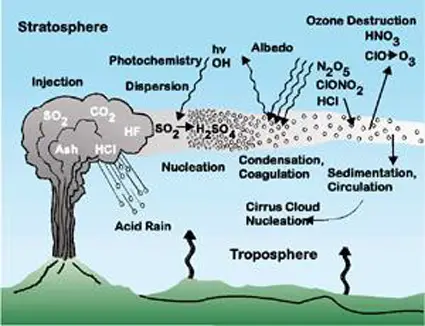 Measuring Volcanic Gases: A volcano is a vent or ‘chimney’ that connects molten rock (magma) to the Earth’s surface. It includes the surrounding cone of built-up material, and magma erupting from a volcano is called lava.
Measuring Volcanic Gases: A volcano is a vent or ‘chimney’ that connects molten rock (magma) to the Earth’s surface. It includes the surrounding cone of built-up material, and magma erupting from a volcano is called lava.
Scientists are quite certain that over a period of several million years, increased volcanism can create enough dust and soot to block out sunlight and produce climatic change. For instance at the end of the Cretaceous period and beginning of the Tertiary (known as the KT boundary) there was increased volcanic activity, with huge volcanic eruptions spewing forth floods of lava. The Deccan traps in India are an example of K-T boundary ruptures in the Earth’s surface, which may have lead to the extinction of dinosaurs.
Volcanic eruptions can contribute to the destruction of stratospheric ozone, and researchers are now suggesting that ice particles containing sulphuric acid from volcanic emissions may contribute to ozone loss. When chlorine compounds resulting from the break-up of chlorofluorocarbons (CFCs) in the stratosphere are present, the sulphate particles may serve to convert them into more active forms that may cause more rapid ozone depletion.

Figure modified by K. McGee et. al., from R. Turco, in Volcanism and Climate Change, 1992.
A further significant impact from large explosive eruptions comes from the conversion of sulphur dioxide (SO2) to sulphuric acid (H2SO4), which condenses rapidly in the stratosphere to form fine sulphate aerosols. The aerosols increase the reflection of radiation from the Sun back into space and thus cool the Earth’s lower atmosphere or troposphere; however, they also absorb heat radiated up from the Earth, thereby warming the stratosphere.
Data from the Stratospheric Aerosol and Gas Experiment (SAGE II) instrument on NASA’s Earth Radiation Budget Satellite (ERBS) have shown that during the first five months after the Mount Pinatubo eruption, the optical depth of the stratospheric aerosol increased up to 100 times in certain locations. Optical depth is a general measure of the capacity of a region of the atmosphere to prevent the passage of visible light through it. Greater optical depth means greater blockage of the light. In this case, the increased optical depth means that considerably less of the sun’s energy can get through the cloud to warm the Earth’s surface.
Instruments Used In Measuring Volcanic Gases
In recent years, scientists have made significant progress in monitoring, interpreting and measuring volcanic gases. Depending on several factors, including a volcano’s eruptive history and potential hazards, the location, active vents, and availability of monitoring resources and expertise, one or more of the following methods might be used to study gases escaping from magma beneath a volcano:
• Measuring gas-emission rates in volcanic plumes
• Direct gas sampling and laboratory analysis
• Continuous on-site gas monitoring
• Soil-efflux measurements


